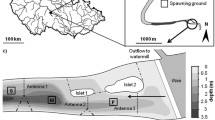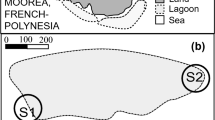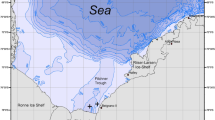Abstract
Spawning behavior of lake trout, Salvelinus namaycush, is poorly understood, relative to stream-dwelling salmonines. Underwater video records of spawning in a recovering population from the Drummond Island Refuge (Lake Huron) represent the first reported direct observations of lake trout spawning in the Laurentian Great Lakes. These observations provide new insight into lake trout spawning behavior and expand the current conceptual model. Lake trout spawning consisted of at least four distinct behaviors: hovering, traveling, sinking, and gamete release. Hovering is a new courtship behavior that has not been previously described. The apparent concentration of hovering near the margin of the spawning grounds suggests that courtship and mate selection might be isolated from the spawning act (i.e., traveling, sinking, and gamete release). Moreover, we interpret jockeying for position displayed by males during traveling as a unique form of male-male competition that likely evolved in concert with the switch from redd-building to itinerant spawning in lake trout. Unlike previous models, which suggested that intra-sexual competition and mate selection do not occur in lake trout, our model includes both and is therefore consistent with evolutionary theory, given that the sex ratio on spawning grounds is skewed heavily towards males. The model presented in this paper is intended as a working hypothesis, and further revision may become necessary as we gain a more complete understanding of lake trout spawning behavior.



Similar content being viewed by others
References
Berst AH, Emery AR, Spangler GR (1981) Reproductive behavior of hybrid charr. Can J Fish Aquat Sci 38:432–440
Bronte CR, Ebener MP, Schreiner DR, DeVault DS, Petzold MM, Jensen DA, Richards C, Lozano SJ (2003) Fish community change in Lake Superior, 1970–2000. Can J Fish Aquat Sci 60:1552–1574
Bronte CR, Holey ME, Madenjian CP, Jonas JL, Claramunt RM, McKee PC, Toneys ML, Ebener MP, Breidert B, Fleischer GW, Hess R, Martell AW Jr, Olsen EJ (2007) Relative abundance, site fidelity, and survival of adult lake trout in Lake Michigan from 1999 to 2001: implications for future restoration strategies. N Am J Fish Manag 27:137–155
Bronte CR, Schram ST, Selgeby JH, Swanson BL (2002) Reestablishing a spawning population of lake trout in Lake Superior with fertilized eggs in artificial turf incubators. N Am J Fish Manag 22:796–805
Claramunt RM, Jonas JL (2005) Influences of spawning habitat characteristics and interstitial predators on lake trout egg deposition and mortality. T Am Fish Soc 134:1048–1057
Clutton-Brock TH, Parker GA (1992) Potential reproductive rates and the operation of sexual selection. Q Rev Biol 67:437–456
DeRoche SE (1969) Observations on the spawning habits and early life of lake trout. Prog Fish Cult 31:109–113
Ebener MP (ed) (1998) A lake trout rehabilitation guide for Lake Huron. Great Lakes Fishery Commission, Ann Arbor
Eschmeyer PH (1955) The reproduction of lake trout in southern Lake Superior. T Am Fish Soc 84:47–74
Eshenroder RL, Payne NR, Johnson JE, Bowen C II, Ebener MP (1995) Lake trout rehabilitation in Lake Huron. J Great Lakes Res 21(Suppl 1):108–127
Esteve M (2005) Observations of spawning behaviour in Salmoninae: Salmo, Oncorhynchus, and Salvelinus. Rev Fish Biol Fisher 15:1–21
Esteve M, McLennan DA, Gunn J (2008) Lake trout (Salvelinus namaycush) spawning behaviour: the evolution of a new female strategy. Environ Biol Fish 83:69–76
Fleming IA (1996) Reproductive strategies of Atlantic salmon: ecology and evolution. Rev Fish Biol Fisher 6:379–416
Foote CJ (1990) An experimental comparison of male and female spawning territoriality in a Pacific salmon. Behaviour 115:283–314
Foster NR (1985) Lake trout reproductive behavior: influence of chemosensory cues from young-of-the-year by-products. Trans Am Fish Soc 114:794–803
Gunn JM (1995) Spawning behaviour of lake trout: effects on colonization ability. J Great Lakes Res 21(Suppl 1):323–329
Hansen MJ (1999) Lake trout in the Great Lakes: Basinwide stock collapse and binational restoration. In: Taylor WW, Ferreri CP (eds) Great Lakes fisheries policy and management. Michigan State University Press, Lansing, pp 417–454
Hansen MJ, Peck JW, Schorfhaar RG, Selgeby JH, Schreiner DR, Schram ST, Swanson BL, MacCallum WR, Burnham-Curtis MK, Curtis GL, Heinrich JW, Young RJ (1995) Lake trout (Salvelinus namaycush) populations in Lake Superior and their restoration in 1959–1993. J Great Lakes Res 21(Suppl 1):152–175
Hanson SD, Holey ME, Treska TJ, Bronte CR, Eggebraaten TH (2013) Evidence of wild juvenile lake trout recruitment in western Lake Michigan. N Am J Fish Manage 33(1):186–191
He JX, Ebener MP, Riley SC, Cottrill A, Kowalski A, Koproski S, Mohr L, Johnson JE (2012) Lake trout status in the main basin of Lake Huron, 1973–2010. N Am J Fish Manage 32:402–412
Hile R (1949) Trends in the lake trout fishery of Lake Huron through 1946. Trans Am Fish Soc 76:121–147
Hile R, Eschmeyer PH, Lunger GF (1951) Status of the lake trout fishery in Lake Superior. Trans Am Fish Soc 80:278–312
Hinde RA (1966) Animal behaviour: a synthesis of ethology and comparative psychology. McGraw-Hill, New York
Kvarnemo C, Ahnesjö I (1996) The dynamics of operational sex ratios and competition for mates. Trends Ecol Evol 11:404–408
Loftus KH (1958) Studies on –river-spawning populations of lake trout in eastern Lake Superior. Trans Am Fish Soc 87:259–277
Marsden JE, Casselman JM, Edsall TA, Elliott RF, Fitzsimons JD, Horn WH, Manny BA, McAughey SC, Sly PG, Swanson BL (1995) Lake trout spawning habitat in the Great Lakes—a review of current knowledge. J Great Lakes Res 21(Suppl 1):487–497
Marsden JE, Krueger CC (1991) Spawning by hatchery-origin lake trout (Salvelinus namaycush) in Lake Ontario: data from egg collections, substrate analysis, and diver observations. Can J Fish Aquat Sci 48:2377–2384
Martin NV (1957) Reproduction of lake trout in Algonquin Park, Ontario. Trans Am Fish Soc 86:231–244
McCrimmon HR (1958) Observations on the spawning of lake trout, Salvelinus namaycush, and the post-spawning movement of adult lake trout in Lake Simcoe. Can Fish Cult 23:3–11
Merriman D (1935) Squam lake trout. Bull Boston Soc of Nat Hist 75:1–10
Mjølnerød IB, Fleming IA, Refseth UH, Hindar K (1998) Mate and sperm competition during multiple-male spawnings of Atlantic salmon. Can J Zool 76:70–75
Muir AM, Krueger CC, Hansen MJ (2012a) Re-establishing lake trout in the Laurentian Great Lakes: past, present, and future. In: Taylor WW, Lynch AJ, Leonard NJ (eds) Great Lakes fisheries policy and management: a binational perspective, 2nd edn. Michigan State University Press, East Lansing, pp 533–588
Muir AM, Blackie CT, Marsden JE, Krueger CC (2012b) Lake charr Salvelinus namaycush spawning behaviour: new field observations and a review of current knowledge. Rev Fish Biol Fisher 22:575–593
Partridge BL, Pitcher TJ (1980) The sensory basis of fish schools: relative roles of lateral line and vision. J Comp Physiol A 135:315–325
Peck JW (1986) Dynamics of reproduction by hatchery lake trout on man-made spawning reefs. J Great Lakes Res 12:293–303
Reid DM, Anderson DM, Henderson BA (2001) Restoration of lake trout in Parry Sound, Lake Huron. N Am J Fish Manage 21:156–169
Riley SC, He J, Johnson JE, O’Brien TP, Schaeffer JS (2007) Evidence of widespread natural reproduction by lake trout Salvelinus namaycush in the Michigan waters of Lake Huron. J Great Lakes Res 33:917–921
Royce W.F. (1951) Breeding habits of lake trout in New York. Fishery Bulletin of the Fish and Wildlife Service Volume 52, Washington
Scott WB, Crossman EJ (1998) Freshwater fishes of Canada. Galt House Publications Ltd., Oakville
Selgeby JH, Bronte CR, Brown EH Jr, Hansen MJ, Holey ME, VanAmberg JP, Muth KM, Makauskas DB, McKee P, Anderson DM, Ferreri CP, Schram ST (1995) Lake trout restoration in the Great Lakes: stock-size criteria for natural reproduction. J Great Lakes Res 21(Suppl 1):498–504
Smith BR, Tibbles JJ (1980) Sea lamprey (Petromyzon marinus) in Lakes Huron, Michigan, and Superior: history of invasion and control, 1936–78. Can J Fish Aquat Sci 37:1780–1801
Acknowledgments
We thank E. Larson, D. Operhall, B. Lamoreux, and C. Wright for their technical assistance in the field. We are also thankful to A. Miehls for her help in editing the videos. The paper was substantially improved based on comments from two anonymous peer reviews. Funding for this project came from the Great Lakes Restoration Initiative to the Great Lakes Fishery Commission. This article is Contribution 1825 of the U.S. Geological Survey Great Lakes Science Center. The findings and conclusions in this article are those of the authors and do not necessarily represent the views of the U.S. Fish and Wildlife Service. Any use of trade, product, or firm names is for descriptive purposes only and does not imply endorsement by the U.S. Government.
Author information
Authors and Affiliations
Corresponding author
Rights and permissions
About this article
Cite this article
Binder, T.R., Thompson, H.T., Muir, A.M. et al. New insight into the spawning behavior of lake trout, Salvelinus namaycush, from a recovering population in the Laurentian Great Lakes. Environ Biol Fish 98, 173–181 (2015). https://doi.org/10.1007/s10641-014-0247-6
Received:
Accepted:
Published:
Issue Date:
DOI: https://doi.org/10.1007/s10641-014-0247-6




